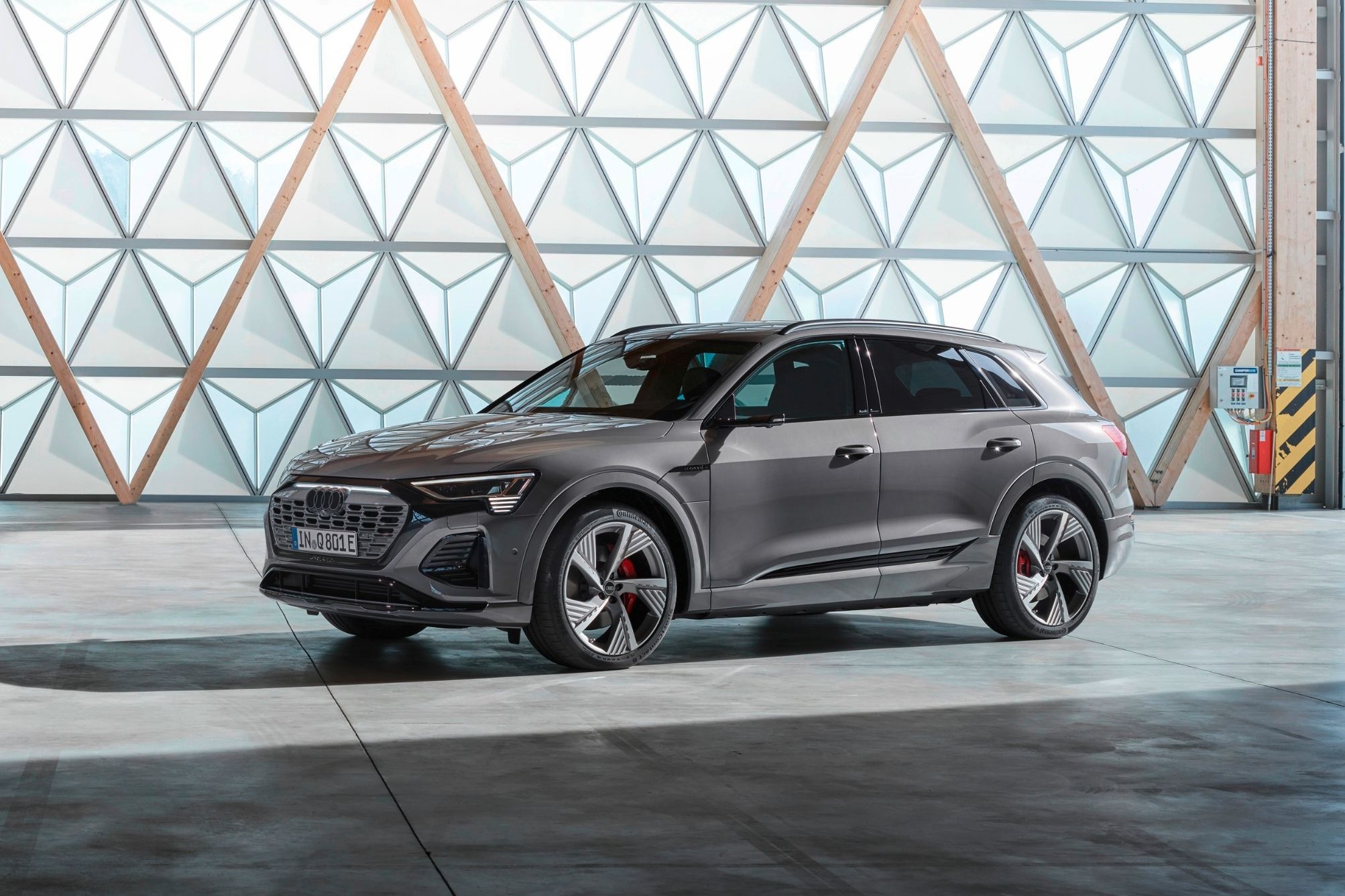
Audi has fully revealed the 2024 Q8 e-tron and Q8 e-tron Sportback, and the SUVs appear to be significant improvements over the outgoing models with increased, power, range, and driving dynamics. Gone are the somewhat confusing e-tron and e-tron Sportback nameplates, and in their place sit the more conventional Q8 moniker. The Q8 e-tron will start at $74,400 with the Sportback a little higher at $77,800.
These new models look to build upon the already excellent e-tron platform, as the space the original e-tron entered all the way back in 2018 has changed significantly with many competitors arriving with very compelling options like the new Kia EV9. The good news is Audi has learned a lot during its electric tenure, and the top-of-the-line Q8 e-tron is looking to steal back some thunder from its competitors.
The big news is the increase in range and charging the models now enjoy. The previous e-tron and e-tron Sportback were only able to muster an EPA-estimated 226 and 225 miles of range, which may have been even worse in real world driving situations. For many vehicles, range like this could be fine in most situations, but when you're talking about a large family hauler, the range is basically the most important aspect.
Audi took a three-pronged approach to tackle the problem: aerodynamics, battery capacity, and engine efficiency. The brand reduced drag in a myriad of ways which included new wheel designs, enlarging the splitters on the front of the models, a new rear spoiler on the Sportback model, and in a first for an Audi model, using a self-sealing aero system in addition to the shutters that automatically close off the radiator.
Updates to the front fascia and how it routes air around and under the car were also added. All of these changes and additions led to a six-percent reduction of drag over the previous model, with coefficients of 0.29 for the regular SUV and 0.27 for the Sportback.
As for the battery, it now benefits from "stacking" technology that permits better use of physical space thereby allowing more energy to be packed into the same battery space. This leads to a 23% greater net capacity of 106 kWh (114 kWh gross) with the usable capacity increasing from 91 to 93%
The asynchronous engine on the rear axle was reworked with additional motor windings which creates a stronger magnetic field that is more efficient in producing the same amount of power as last year's model. Base power is now equal to the mid-range model from last year at 355 hp and 414 lb-ft of torque which can be temporarily boosted to 402 hp and 490 lb-ft of torque. This is good for 0-60 sprints of 5.3 seconds for the Sportback.
All of these additions and subtractions lead to a significant increase in range: an EPA-estimated 300 miles for the Sportback which is a 30% increase over last year. The company doesn't mention the regular Q8's range in the press release, leading us to believe it wasn't able to break the 300-mile range benchmark.
To help replenish this range, maximum DC fast charging power has been increased from 150 kW to 170 kW, leading to a 10 to 80% charge in about 31 minutes. This means at-home level-two charging can replenish the battery in about 6.5 hours with a 19.2 kW charger or 13 hours with a 9.6 kW one. This is on par with what other luxury EV SUVs like the Mercedes EQE SUV offers, but it's still down from the 195 kW fast charging available on the BMW iX SUV.
The benefit of getting an Audi though is the addition of two years of Electrify America DC fast charging included with the Plug & Charge feature. This, over time, can lead to some nice savings, especially since charging rates have gone up.
Now to make the driving experience more exciting, the handling has been improved as well. The progressive steering is now more direct with a quicker 14.6:1 steering ratio. This means "faster" steering for more direct feedback with the help of a more rigid front-axle bearing.
In fact, many components had rigidity increased which, in addition to the air suspension, helps to improve body roll that was pronounced in the past. Finally, the driving modes have been recalibrated to differentiate them more and create more obvious changes in the vehicle's demeanor.
As for the rest of the two vehicles, most is left unchanged which isn't a bad thing. On the exterior, the cars now benefit from new front and rear fascias that serve functional and aesthetic purposes. A new lighting design in the front is activated whenever the headlights or parking lights are turned on that emanates from beneath the hood line and adds depth to the Audi logo. Additionally, this is also the first Audi to benefit from laser etching, with a logo on the B-pillar.
The interior is as lovely as one would expect too, with plush surfaces and tons of technological features that blur the lines between family hauler and luxury yacht. Screens are the name of the game now and the Audis are no different with two lower (8.6-inch) and upper (10.1) screens on the center console in addition to the digital display in front of the driver.
A large two-part glass roof sits above you, with three-stage seat ventilation underneath you with eight-way adjustable seats and massage functionality. Four-zone climate control will make sure every occupant is happy, and available double acoustic glass ensures the outside world is kept outside.
The different trims, Premium, Prestige, and Premium Plus will offer the driver a luxurious and comfortable experience like the trims in past models. The benefit this time around is the car has the performance to make the vehicle the whole package it should have been before. Audi says the 2024 Q8 e-tron and Q8 e-tron Sportback will be in US showrooms this summer and the more powerful SQ8 e-tron will debut later this year.
